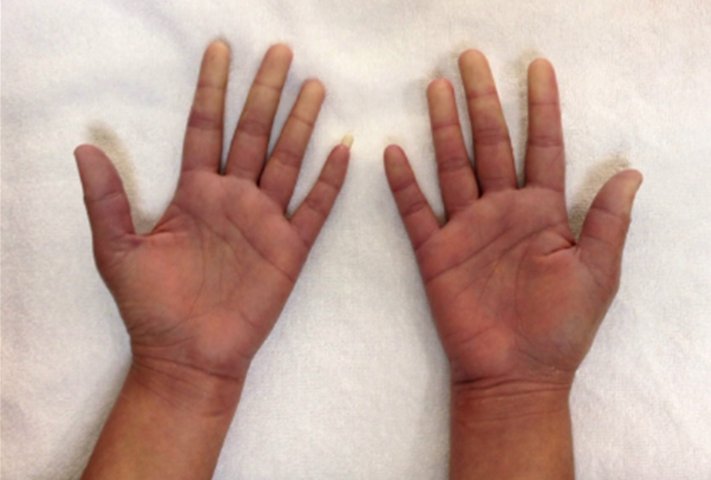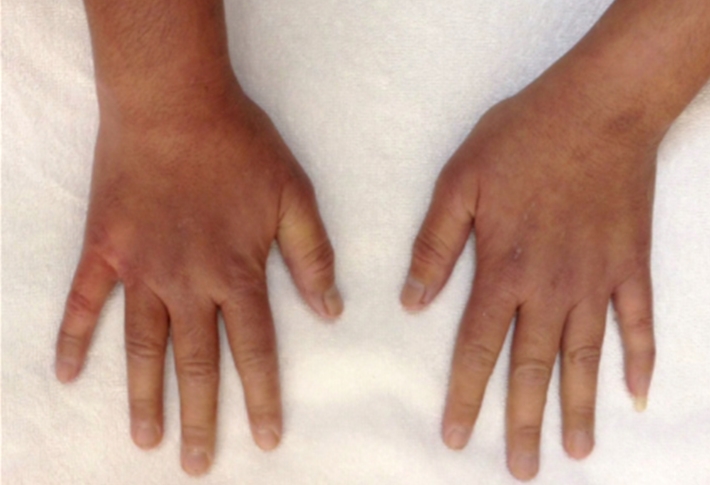Carbimazole induced ANCA Positive Vasculitis
Yasmeen Ajaz and Sameem Matto
Cite this article as: BJMP 2014;7(2):a712
|
|
Abstract Anti-throid drugs like propylthiouracil and carbimazole are the main drugs prescribed for hyperthyroidism worldwide. Vasculitis related to anti-thyroid medication is very rare and can be potentially life threatening, if not recognized early. We report a female patient with Graves’ Disease who developed ANCA positive vasculitis due to carbimazole. The episode was characterized by a Raynaud’s Phenomenon of hands and feet and small joint arthritis. To our knowledge this is the first ANCA positive carbimazole induced vasculitis case reported from United Arab Emirates. Keywords: Carbimazole, ANCA, Vasculitis, Hyperthyroidism, Raynauds Phenomenon, Graves Disease, Antithyroid Drugs.Abbreviations: TSH-Thyroid stimulating hormone, FT3-Freetri-iodothyronine, FT4-Free thyroxine, ANCA-Antineutrophilic cytoplasmic antibodies, CRP-C reactive protien, ESR-Erythromicin sedimentation rate, ECG-electrocardiogram, ATD-Antithyroid drugs, PTU-Proplythiouracil, ANTI-TPO-thyroperoxidase, MPO-Myeloperoxidase |
Introduction
Hyperthyroidism is a common endocrine disorder and is mainly treated with anti-thyroid medications like propylthiouracil (PTU) and carbimazole. These medications have a large number of adverse effects, the commonest being skin rashes, and some are rare like agranulocytosis. Vasculitis is uncommon, but ANCA positivity is reported more in propylthiouracil and rarely with carbimazole or methimazole (1).We report a female patient with Graves’ disease who developed ANCA associated vasculitis while on carbimazole treatment.
Case report
A 29 year old female Filipino patient came to us with history of palpitations, tremors and weight loss for the last one month. Her thyroid profile showed severe hyperthyroidism (TSH <0.005, FT3-11.5, FT4-45.6) She was diagnosed with Graves’ disease as her anti-TSH receptor positive and was started on carbimazole 10mg tds. After three weeks of treatment, she developed macular rash over arms and legs and swelling of small joints of both hands. She noticed pain and colour change of both the hands and experienced typical Raynaud’s phenomenon. She had no renal or lung involvement.
On examination her blood pressure was 120/84mmHG, pulse 104 beats per min, temperature -37.1̊C. She had a mild diffuse goiter. Her X-ray chest, ECG and urine dipstick routine were all normal. Her CRP and ESR were raised. X-rays of the hands were normal. P-ANCA was positive. Antimyeloperoxidase antibody was positive. Anti-TPO and TSH receptor antibodies were positive.
Diagnosis of carbimazole induced vasculitis was made. The patient was treated with prednisolone 40mg daily once daily which was tapered over three weeks. She improved within 48hours and was asymptomatic after three weeks. She was treated successfully with radioiodine ablation. Her MPO-ANCA after 6 months was negative.

Figure 1. Pictures of the hands showing Raynaud’s phenomenon

Figure 2. Pictures of the hands showing Raynaud’s phenomenon
Discussion
ANCA positive vasculitis in association with antithyroid drugs was first reported in 1992 (2).There has been 32 cases of ANCA positive vasculitis associated with antithyroid medications reported up until now (3). The presenting symptoms are variable and may include renal involvement (67%), arthralgias (48%), fever (37%), skin involvement (30%), respiratory tract involvement (27%), myalgias (22%), scleritis (15%) and other manifestations (18%) (3).
In these patients the underlying thyroid disease is most commonly Graves’ disease but ANCA positive vasculitis has also been seen with association with toxic multinodular goitre (4). Recent studies have shown high frequency of ANCA positivity in patients with Graves’ disease treated with antithyroid medications, especially with PTU. Most cases of ANCA positivity are seen in patients on long term therapy (greater than 18 months) or in those with recent commencement of therapy as seen in our patient. However, a small percentage of these go on to develop features of vasculitis (3).
The majority of cases of vasculitis (88%) have been reported in association with PTU, vasculitis associated with carbimazole is very rare (5, 6, and 7). The pathogenesis of ATD associated vasculitis is not clearly understood. PTU has been shown to accumulate within neutrophils (8) and bind myeloperoxidase (9). The binding alters the configuration of myeloperoxidase (9) and may promote formation of autoantibodies in susceptible people. There has been no data with regards to whether carbimazole can alter the configuration of myeloperoxidase. ANCA positive vasculitis may be more common in patients of Asian ethnic origin, with half of cases reported from Japan (3). Our patient was from Philippines.
Wadw et al have reported 25% of patients were positive for MPO-ANCA in PTU group whereas in methimazole group 3.4% were positive (10).
This case highlights the awareness of this relatively rare adverse effect of a thyroid medication which may lead to fatal renal and pulmonary complications. Early diagnosis and withdrawal of the offending medication is important. In asymptomatic patients the significance of ANCA positivity is not clear but early definitive therapy in the form of radioiodine ablation or surgery should be considered.
|
Acknowledgements NONE Competing Interests None declared Author Details YASMEEN AJAZ (M.D, F.A.C.E, PGDD, SCE) Specialist Internal Medicine And Endocrinology, Belhoul Speciality Hospital, Dubai, UAE. SAMEEM MATTO (M.D, PGDD, SCE) Specialist Internal Medicine And Endocrinology, Canadian Specialist Hospital, Dubai, UAE. CORRESPONDENCE: DR SAMEEM MATTO, Canadian Specialist Hospital, Abuhail Deira, PO BOX 15881, Dubai, UAE. Email: sameematto@hotmail.com |
References
- Sera N, Ashizawa K, Ando T, et al. Treatment with propylthiouracil is associated with appearance of antineutrophil cytoplasmic antibodies in some patients with Graves’ disease. Thyroid 2000; 10:595-9.
- Stankus SJ & Johnson NT. Propylthiouracil-induced hypersensitivity vasculitis presenting as Respiratory failure. Chest 1992 102, 595–1596.
- Gunton JE, Stiel J, Clifton-Bligh P, et al. Prevalence of positive antineutrophil cytoplasmic antibody (ANCA) in patients receiving antithyroid medication. Eur J Endocrinol 2000; 142: 587-96.
- Gunton JE, Stiel J, Caterson RJ & McElduff A. Anti-thyroid drugs and antineutrophil cytoplasmic antibody positive vasculitis. A case report and review of the literature. Journal of Clinical Endocrinology and Metabolism1999 8413–16.
- Day C, Bridger J, Rylance P, et al. Leukocytoclastic vasculitis and interstitial nephritis with Carbimazole treatment. Nephrol Dial Transplant 2003; 18: 429-31.
- Sève P, Stankovic K, Michalet V, et al. Carbimazole induced eosinophilic granulomatous vasculitis localized to the stomach. J Intern Med 2005; 258: 191-5.
- Calañas-Continente A, Espinosa M, Manzano-García G, et al.Necrotizing glomerulonephritis and pulmonary hemorrhage associated with carbimazole therapy. Thyroid 2005; 15: 286-8.
- Lam DCC & Lindsay RH. Accumulation of 2-[14C]-propylthiouracil in human polymorphonuclear leukocytes. Biochemical Pharmacology 1979 282289–2296.
- Lee H, Hirouchi M, Hosokawa M, Sayo H, Kohno M & Kariya K.Inactivation of peroxidase of rate bone marrow by repeated administration of propylthiouracil is accompanied by a change in the heme structure. Biochemical Pharmacology 1988 372151–2153.
- Bonaci-Nikolic B, Nikolic MM, Andrejevic S, et al. Antineutrophil cytoplasmic antibody (ANCA)-associated autoimmune diseases induced by antithyroid drugs: comparison with idiopathic ANCA Vasculitides. Arthritis Res Ther 2005; 7:1072-81.

The above article is licensed under a Creative Commons Attribution-NonCommercial-NoDerivatives 4.0 International License.




